Daily post 09 Aug 2008 08:12 am
Dil & Dali
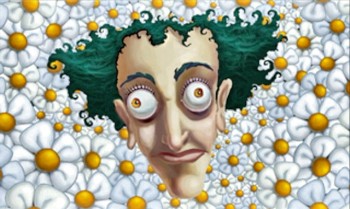 – John DIlworth wrote from Spain that his film, Life in Transition, will be playing this month at the Museum of Modern Art. The film will be on the same bill as Federico Fellini’s The White Shiek.
– John DIlworth wrote from Spain that his film, Life in Transition, will be playing this month at the Museum of Modern Art. The film will be on the same bill as Federico Fellini’s The White Shiek.
The description, according to MOMA’s catalogue states that, “Dilworth explores metamorphosis, a main concept in Surrealism, in Life in Transition, unquestionably an homage to DalÃ.”
The first screening will be this coming Wednesday, August 13, at 7:30 p.m.
It’ll repeat on Saturday, August 23, at 5:30 p.m.
- It’s nice to have been ever-so-slightly ahead of the curve.
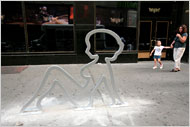 Recently, I had a post about bicycle stands around the city and the various shapes they take. What I didn’t realize was that David Byrne has been obsessed with all things bicycle, and he has designed a number of bike racks around the midtown area. There’s an article in today’s NYTimes about his recent artwork/sculptures for the bicycle. It’s worth a look.
Recently, I had a post about bicycle stands around the city and the various shapes they take. What I didn’t realize was that David Byrne has been obsessed with all things bicycle, and he has designed a number of bike racks around the midtown area. There’s an article in today’s NYTimes about his recent artwork/sculptures for the bicycle. It’s worth a look.
Now, back to John Dilworth:
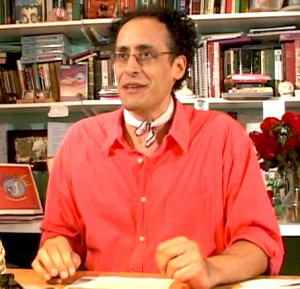 John also sent the following interview that was conducted by Lindsey Hawkins, they’re all questions from fans about Courage the Cowardly Dog:
John also sent the following interview that was conducted by Lindsey Hawkins, they’re all questions from fans about Courage the Cowardly Dog:
- 1. You have indeed met Simon Prebble, how did he like his role?
Simon enjoyed his role very much. He had a natural rapport with the personality of the Computer. However, Simon is an English gentleman who liked to laugh, where the Computer is a clever, but remote cynic, not concerned with human pathos. I had wanted a symbolic object to represent contemporary obedience to technology as “master” for Courage to confide in. The “home” computer was the logical “paternal” replacement.
I’m a bit of a fan of his other work in other things so I’d like to know.
2. Is there any hope of continuing Courage?
Well, humans have a tremendous capacity to “hope”. I have written so often on this. There is no corporate economic rational to make any new episodes. I’ve read that there have been petitions signed by many many fans that never even got to Cartoon Network. Maybe a campaign of a substantial nature of this kind, that actually got to an exec, would be a provocation. However, the lack of courage by the merchandisers still remains. “Pink” or “fuchsia” dogs will not sell in a boy dominated market place. This is rather complex, but the undercurrent of conservatism in America is strong and easy to intolerance.
3. What was your inspiration when you created the various villains?
Well, the villains were archetypes of human qualities or beliefs. Greed was a big character quality. Many of the villains were needy or hungry for something more; power, possession or privilege. Yet, I wanted to show a
“human” frailty in these villains, that they were vulnerable. Courage often was able to soften the villainous acts of these characters by being a “therapist”. For me, contemporary society is unable or unwilling to listen anymore. Maybe this is a product of conditioning over a long period of technological change that doesn’t promote much more than insecurity. The further humans retreat into the virtual, the more it appears the qualities that make humans “human” are endangered, qualities like tolerance, attention, inquiry…
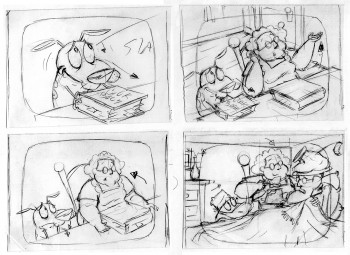 4. What was the original intent of the show when you created it?
4. What was the original intent of the show when you created it?
Science fiction is a genre that appeals to me so I may disguise my “rescue fantasy” complex. I wanted to “help” people, “save” someone, do something romantic and noble as “sacrifice” my safety for the safety of others. Courage was capable of doing this in the unreality of the animation landscape. Animation are dreams visualized. Visualized dreams are human desires calling out for an audience. Let’s not omit the common desire to make audiences laugh. In many ways, producing Courage enabled me to explore my sub-conscious and reveal some of my demons like abandonment of devotion, loss of honor, lack of self-expression. I was able to find mediums to best portray emotional landscapes like clay, CGI or cutouts. Any long term commitment develops as nature develops, things grow where non did before and as an artist/custodian I decide what to nurture and what to reverse. Then, like in nature, some things develop on it’s own while others don’t make it at all.
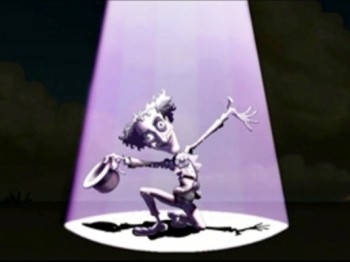 5. Where did you get that guitar sound from the beginning of the ‘Heads Of Beef’ episode?
5. Where did you get that guitar sound from the beginning of the ‘Heads Of Beef’ episode?
Jody Gray and Andy Ezrin are exception musical talents who enjoyed to work intuitively and spontaneously. Although I cannot recall any specific guitar experience, often we would sit around experimenting with what sounds come out of objects and instruments. Other times I would bring in ideas I heard outside the studio that would inform a new sound. I recall one inspirational moment was on an episode when Nowhere was underwater from the construction of a dam. Jody and Andy found an abandoned grand piano and opened it up. They began plucking, hitting and scratching the guts of the thing and recorded it. These sounds were used as the aquatic ambiance for the show.
6. Where did you get your inspiration for Courage, Eustace, and Muriel?
Three is a cultural number representing both the secular and the divine, the single child of working class families and a geometry, the pyramid. I have always been intuitively attracted to this number. Curiously, I was reminded of the my mythological trilogy of personae in a recent text. My films have exhibited this contradiction to “three’s a crowd” from the beginning of my life as an artist. When Lilly Laney Moved In, Smart Talk with Raisin, the Noodles & Nedd films and Angry Cabaret featured “three’s”. But it is in Raisin that the closest ancestors to Courage can be found. The dog star of the short was named Hamilton, and resembled Courage physically and even emotionally. Raisin’s brother, Malcolm is the Farmer as a boy. I recently gave a talk at a museum in Barcelona on how animation liberates the human spirit. I analyzed the mythological motifs of several of my films as a demonstration of auto-discovery through animation. It is apparent to me that the archetypes of the emotionally sensitive deliverer, the remote and rancorous brute and the nurturing “maternal” figure recur often in my work. Inspiration is also a matter of subconscious processes made conscious through will.
7. Why did you add words with sound like ‘smack, bang, bonk’ when a character screams or gets hit?
Originally I aspired to be a cartoonist and studied under Will Eisner at the School of Visual Arts in NYC, a very print dominated facility. Print cartoons are merely the beginning stage of the next, movement. Visual sound effects are a part of my vocabulary of animation as the grin or irrational reaction. I am also aware of how elements from different studies can compliment one another and add a bit of variety to a visual language.
8. Chris Gammon would like to know when you can get in touch with him again.
Chris is a good soul. Thank you for the message. I shall send him a Dilly greeting.
9. Where you got the ideas for The Queen Of The Black Puddle and Fred? Particularly if you got the inspiration for The Queen from mythology.
The Queen from the Black Puddle is a parody of the sci-fi film Creature from the Black Lagoon. Many of the Courage episodes were parodies of my favorite horror/sci-fi/supernatural films. Queen/Creature had an implicit 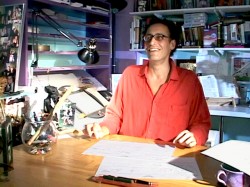 sexual message. The object of desire was to be “taken” at any cost. The irony in Courage is that who would imagine the Farmer as being the object of anyone/anything’s desire?
sexual message. The object of desire was to be “taken” at any cost. The irony in Courage is that who would imagine the Farmer as being the object of anyone/anything’s desire?
10. Why did you make it the middle of nowhere? If you use Google Earth you can find that there is indeed a real Nowhere, Kansas! Did you get the idea for it from that town?
I had no idea that a town with the same name existed. I wanted to portray a pseudo-village, a reverie and melancholia of places in America that proved no longer an economic imperative. To me, when a national chain or an international company decides to shut it’s doors the town that was dependent on that industry becomes enchanted, as if put under a sleeping spell, went from somewhere to nowhere.

on 09 Aug 2008 at 11:16 am 1.Emmett Goodman said …
So much information here, and yet so insightful. John Dilworth has always had something complex going on deep beneath his work. It doesn’t always come out, because I think viewers are caught by the balance of emotion and outrageous humor (at least I am). Courage was such a unique show, as it had more surrealism to it than other Cartoon Network shows at the time. And while some of the other shows made reference to modern day figures, Courage, like Mr. Dilworth mentions here, was always based on memories of old culture. Its a shame about the conservatism and intolerance here in America.
I am curious about what Mr. Dilworth is working on in Spain. I can’t wait to see what he brings out next.
on 11 Aug 2008 at 7:37 am 2.Luke Farookhi said …
Thank you for posting this interview. I have been a fan of John Dilworth’s work ever since seeing ‘The Chicken From Outer Space’ as a boy. There was something about the style of ‘Courage’ that made it miles ahead of any other cartoon at that time, for me.
on 24 Aug 2008 at 2:23 am 3.Dan O'Connor said …
Thanks for posting this. I miss John very much, but I’m delighted that he’s in Spain and living well.
on 05 Aug 2014 at 5:44 am 4.Hugh Bermudes said …
Nice post, had a good read!
on 03 Apr 2019 at 2:13 pm 5.On Courage, Part Two: Dustbowl Theater - The Moon Bog Consortium said …
[…] works as tenuous, but the idea was acknowledged by the creator of Courage himself. In a great interview from 2008, series creator John Dilworth discloses the political context that informs the design of […]
on 29 Sep 2022 at 4:55 am 6.What Is The Last Episode Of Courage The Cowardly Dog – KeepingDog said …
[…] a 2008 interview, Dilworth was asked if there was any hope of Courage returning. He said, “Well, humans have a […]
on 23 Jan 2023 at 6:01 am 7.How many seasons does Courage the Cowardly Dog have? A Step-by-Step Guide – KeepingDog said …
[…] a 2008 interview, Dilworth was asked if there was any hope of Courage returning. He said, “Well, humans have a […]